Exploration
NORTHERN MINERALS ASSETS SIT WITHIN A UNIQUELY DYSPROSIUM AND TERBIUM RICH MINERAL SETTING STRETCHING FROM THE KIMBERLEY REGION IN WESTERN AUSTRALIA INTO THE NORTHERN TERRITORY, WITH ITS STRUCTURAL GEOLOGY AND MINEROLOGY WELL UNDERSTOOD.
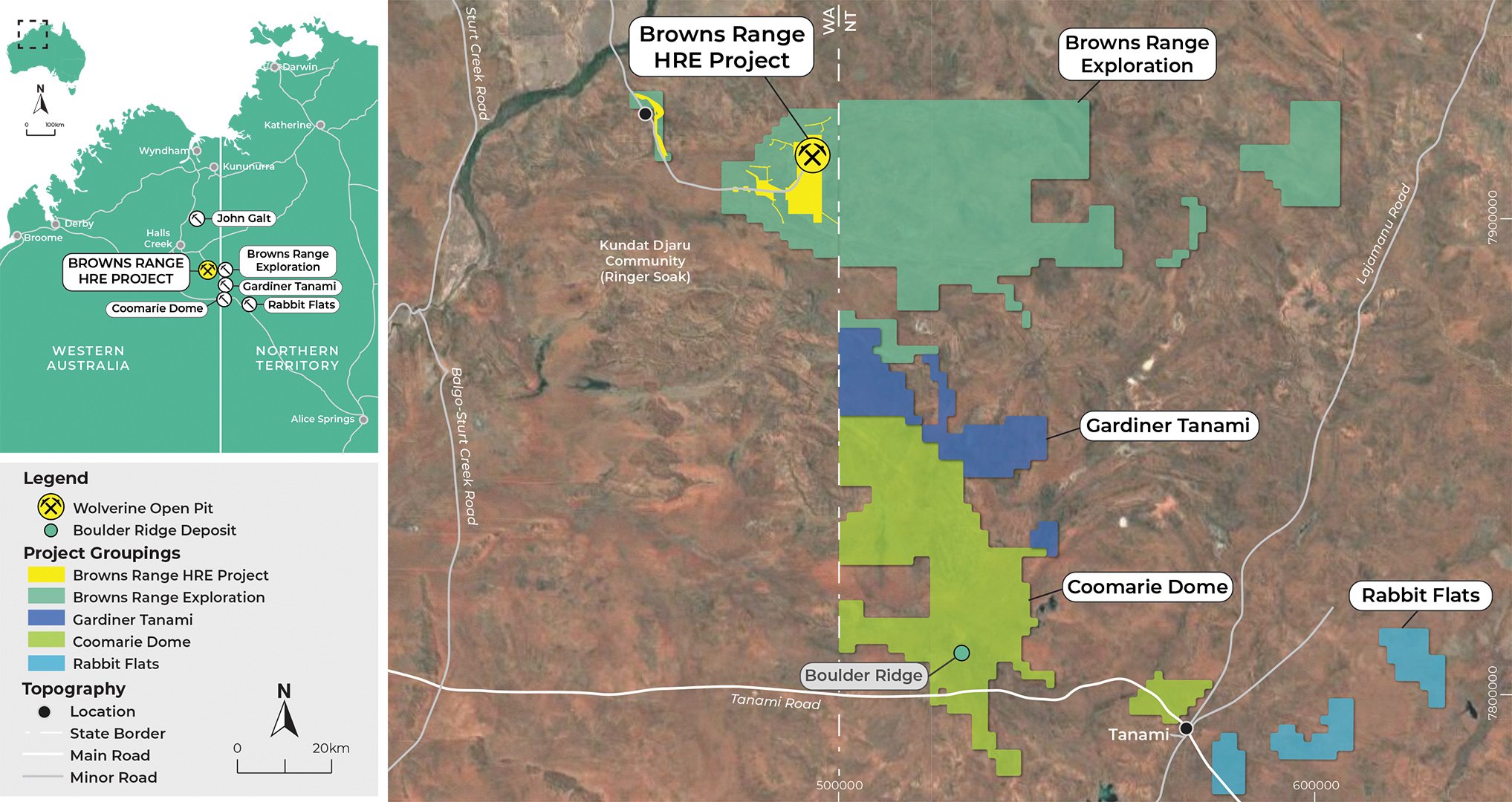
Exploration by Northern Minerals follows a scaled Mineral Systems Approach, which involves the identification of the 4 key elements that are most important in determining the mineral prospectivity of an area. The key elements include identification of the source of the metals, development of structural architecture to focus fluids, a favourable tectonic setting, and the near-surface preservation potential of the deposit.
Exploration is an iterative process where the knowledge acquired from evaluation of various geological, geochemical, and geophysical datasets is used in the next phase of evaluation to ultimately reduce the exploration space and increase the chances of mineral discovery.
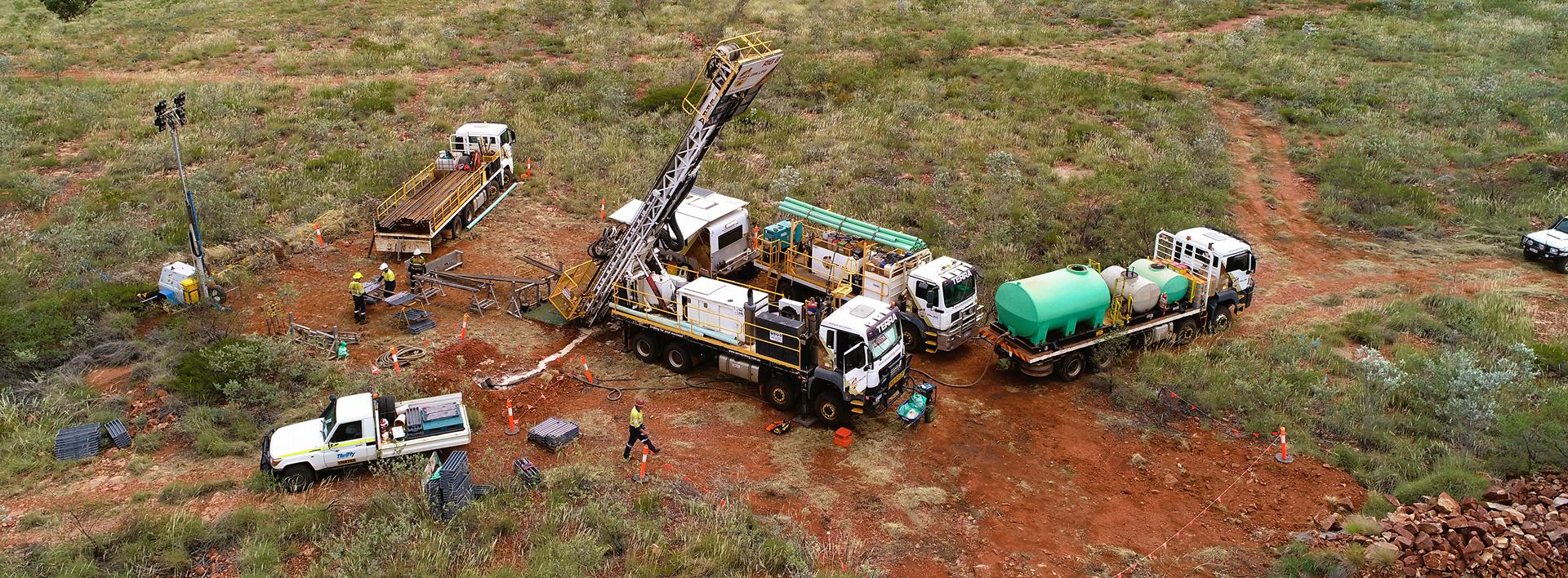
Browns Range
Browns Range represents a highly prospective region which includes the Browns Range Dome, a member of the Paleoproterozoic Grimwade intrusive suite, and its surrounding margins. It is a major geological feature located in the northern Tanami region, traversing the Western Australia (WA) and Northern Territory (NT) border. Spanning approximately 3,000 square kilometres and home to Northern Minerals’ flagship Wolverine deposit, the Dome and surrounding margins are highly prospective for Heavy Rare Earth Element (HREE) mineralisation.
Northern Minerals has focused primarily on advanced exploration of the 100% owned WA tenements, which contain the Dazzler, Banshee, Area 5, Cyclops, Polaris, Mystique and Rockslider deposits. Ongoing exploration continues for both the WA and NT areas to further develop the deposits and prospects and identify new opportunities.
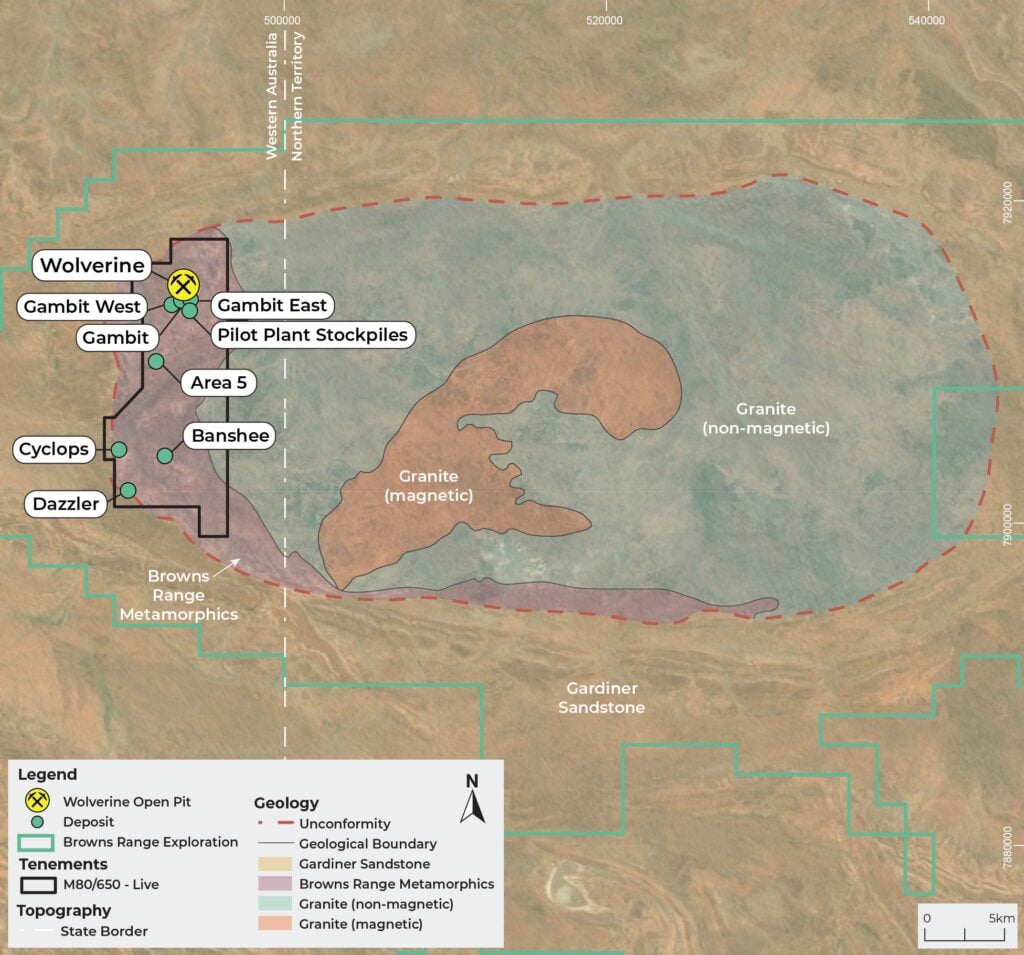
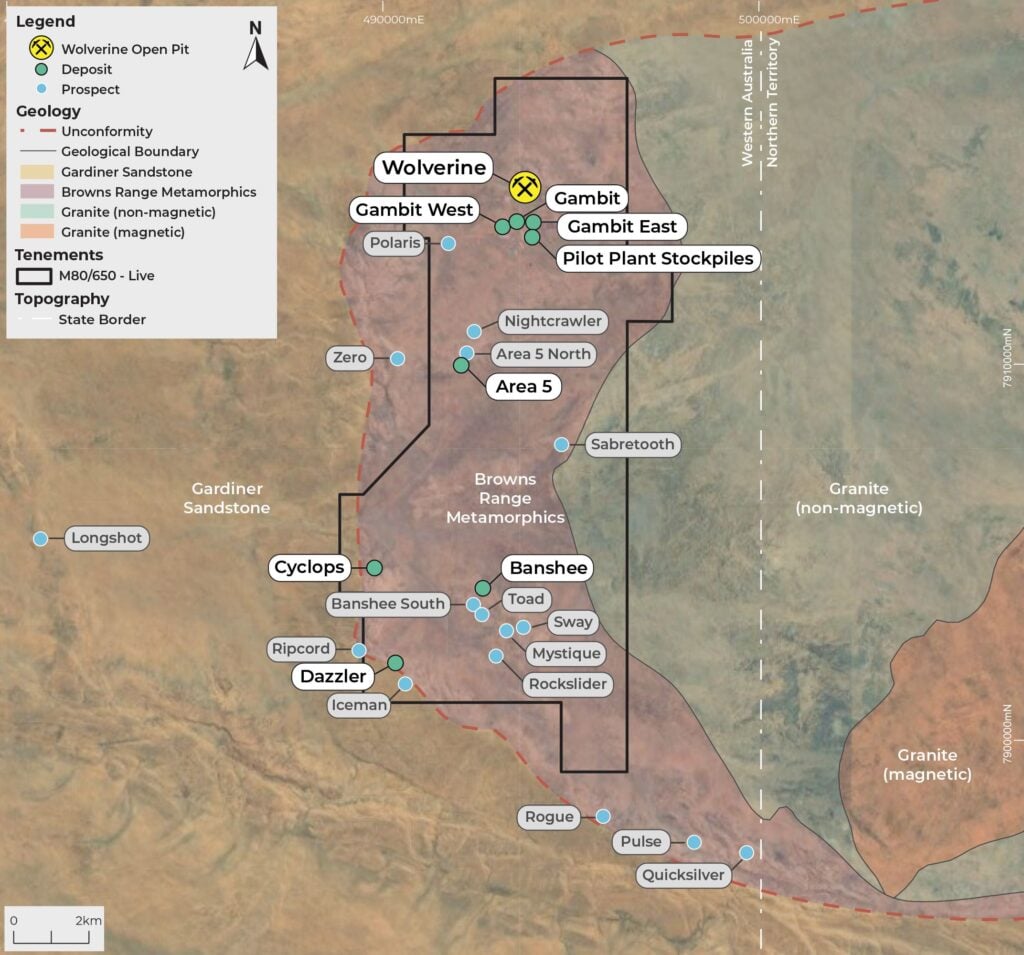

Dazzler Deposit
Dazzler is the is the second largest HREE deposit in the Browns Range and lies approximately 13 km south of the flagship Wolverine deposit. The deposit differs from Wolverine and other HREE deposits in the Browns Range because it is located at the regional unconformity between the Paleoproterozoic Gardiner sandstone of the Birrindudu Group and the underlying Paleoproterozoic/Archean Browns Range Metamorphics. The unconformity-related HREE mineralisation is largely confined to a thin argillitic mudstone unit at the base of the Gardiner Sandstone above the underlying Browns Range Metamorphics. A segmented and steeply-dipping, NW-trending “Transfer” fault has down-dropped large fault blocks to the east creating a series of half-grabens that were subsequently cut by NE- and ENE-trending faults. A recent 5-hole diamond drilling program has revealed many new geological features at depth beneath the Mineral Resource Estimate (MRE) including a new volcanic unit with multiple styles of hydrothermal xenotime-florencite mineralisation. A new Mineral Systems model incorporating these new geological and structural data is being used to target new mineralisation at Dazzler.
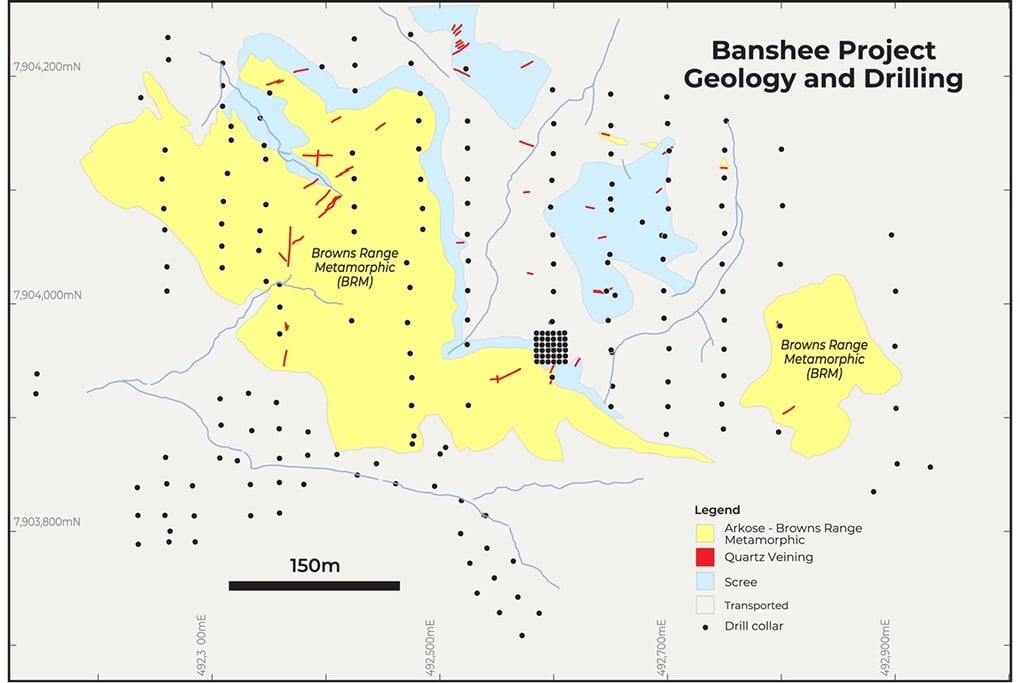
Banshee Deposit
Banshee is located approximately 11 km south of the Wolverine deposit and was identified by outcropping quartz-hematite veins and exposed rocks with anomalous radioactivity and elevated HREE and LREE abundances. Mineralisation at Banshee consists of disseminated xenotime-florencite in permeable strata dipping shallowly to the SW. The stratabound nature of the mineralisation suggests potential for a large tonnage, but lower grade HREE-LREE deposit. A conceptual model for Banshee suggests the existence of deeper structures that have focused hydrothermal fluids into overlying permeable strata. A higher grade “Wolverine style” breccia is envisioned to lie beneath the current Banshee MRE. Further drilling of the Banshee deposit has the potential to extend the mine life of the Browns Range Project and a mineral resource update and associated evaluation studies are currently underway.

Coomarie Dome
The Coomarie Dome is a major geological feature in the southern Tanami region of the Northern Territory (NT). The dome belongs to the same Paleoproterozoic Grimwade intrusive suite as the Browns Range Dome. Areas marginal to the Dome have been explored for Au and REEs since the 1960’s where the potential for REEs was first noted with the discovery of anomalous radioactivity associated with uraniferous xenotime. The many geological similarities with the Browns Range Dome creates a compelling exploration opportunity for Northern Minerals, which holds a large tenement grouping immediately west of the dome. These tenements are contiguous with the Gardiner-Tanami tenement grouping to the north providing the company with a continuous package of tenements over this highly prospective region of the NT.
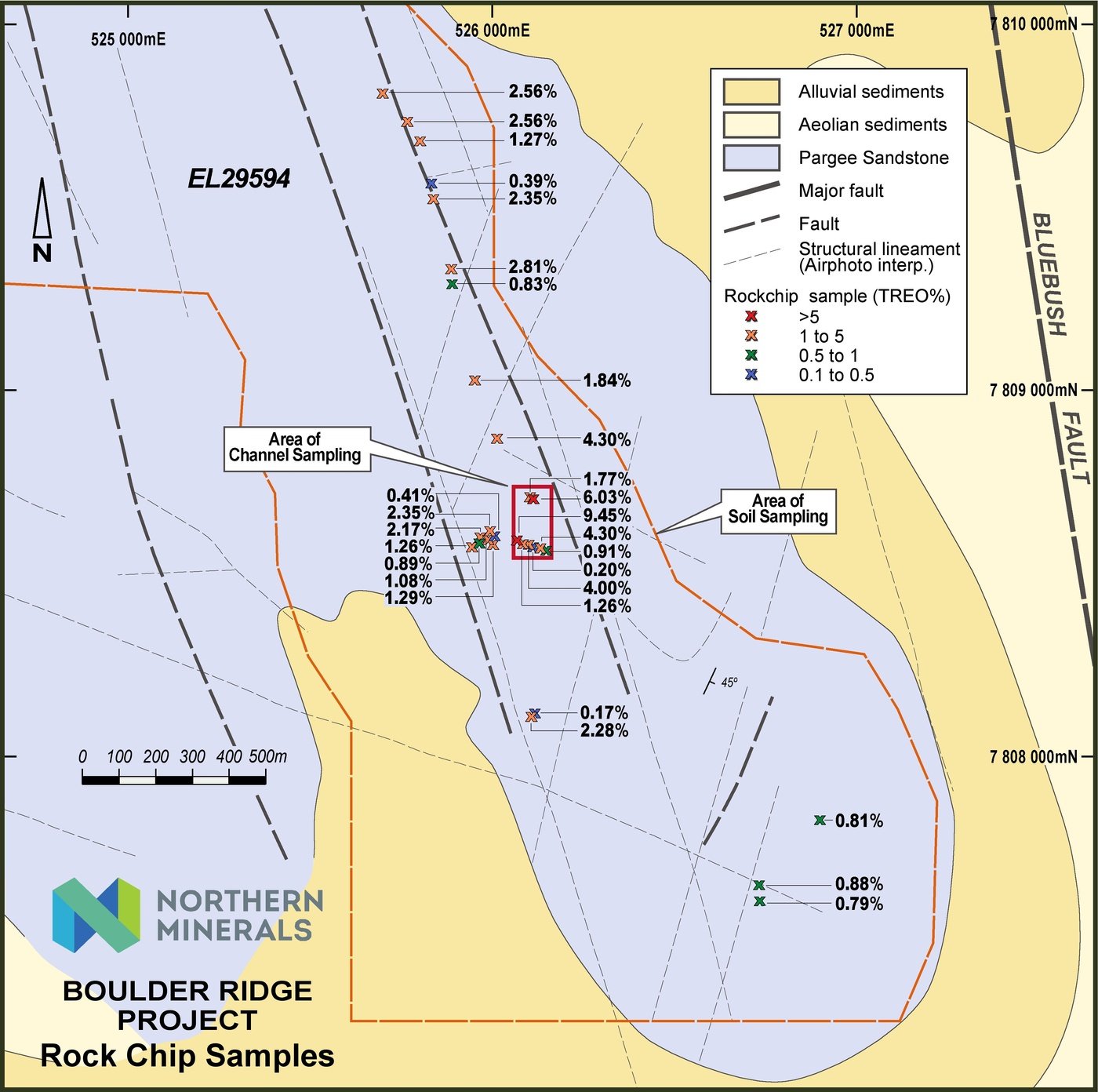
Boulder Ridge
The Boulder Ridge Project is located 150 km south of the Browns Range Dome along the western margin of the Coomarie Dome. The HREE mineralisation consists of xenotime in quartz-hematite veins and breccias that are preferentially developed in quartzites of the Pargee sandstone. This style of mineralisation is similar to that developed at the Wolverine deposit and many other HREE prospects in the Browns Range. The HREE mineralisation at Boulder Ridge also occurs with auriferous quartz veins at several locations suggesting that long lived regional structures focused late HREE hydrothermal fluids into reactivated structures hosting earlier Au mineralisation. An updated litho-structural map of the project area using recently acquired 2023 and 2024 airborne geophysical survey data will be complemented by ultrafine soil geochemistry surveys and detailed geological mapping to refine HREE targets and identify new ones.

Gardiner Tanami
The Gardiner Tanami area is prospective for U and HREE deposits based on the unconformity between the metasedimentary rocks of the Birrindudu Group and the underlying Paleoproterozoic/Archean rocks of the Killi Killi Formation, part of the Tamami Group. The area also has been actively explored for gold associated with large faults and folds, and chemically favourable lithologies. Such a geological setting hosts major gold deposits at Callie in the Granites Goldfield to the south. Northern Minerals is using aeromagnetic and radiometric geophysical survey data in combination with geological mapping to identify the most prospective HREE targets in the Gardiner Tanami tenement package.

Rabbit Flats
The Rabbit Flats tenement group lies immediately east of the Tanami village in the NT and is prospective for Au and potentially HREEs. The Tanami region has a diversity of Paleoproterozoic and Archean rocks, which have undergone complex polyphase deformation and regional metamorphism associated with the Tanami Orogeny (1845-1835 Ma). The Au mineralisation event occurred at approximately 1800 Ma, whereas the potential HREE event would be younger. Northern Minerals is currently re-evaluating the geology of the Rabbit Flats area using new concepts to identify potential HREE and Au targets.

John Galt
The John Galt prospect occurs in the East Kimberley region of western Australia approximately 200 km south of Kununurra. It is prospective for both Cu (Co, Zn) and HREEs. It was first explored for HREE mineralisation in the early 1970’s with several zones of hydrothermal xenotime identified in outcrop. Northern Minerals subsequently identified a zone of vein-hosted Cu oxides and carbonates within metasedimentary rocks of the Red Rock Formation. This Cu mineralisation could represent part of a structurally controlled sediment-hosted Cu system. To test this hypothesis, a detailed gravity survey was conducted over the Cu prospect in 2020, which was followed in 2024 by an Induced Polarisation (IP) geophysical survey. Several shallow chargeability anomalies, potentially representing Cu sulphide accumulations, were identified. Surface expressions of Cu mineralisation over these anomalies will be tested by an ultrafine soil survey followed by drilling.

This figure shows the inversion results for Line 5 of the IP survey. The top panel is a section of the resistivity, and the bottom panel shows the chargeability results with anomalies circled in black.